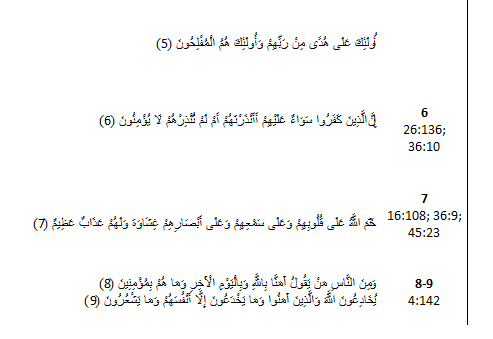Qur’anic Cross References and Tafsir al-qur’an bi-l-qur’an
By Mun’im Sirry
[youtube=http://www.youtube.com/watch?feature=player_embedded&v=zneH1g3U8cg]
A part of the Qur’an Seminar, a year-long initiative directed by Gabriel S. Reynolds from the University of Notre Dame, is to develop a project on cross-references of the Qur’an. This cross-references project will provide for nearly every verse in the Qur’an a selection of other verses which shed light upon, clarify, or explain the verse you are reading.
As is known, the Qur’an in its printed edition has not yet been cross-referenced, in spite of the fact that al-mufassirūn (Qur’an commentators) realized quite early on the central importance of tafsīr al-Qur’an bi al-Qur’an (interpreting the Qur’an through the Qur’an itself). Even some modern Qur’an exegetes like the Iranian scholar Muḥammad Ḥusayn Ṭabaṭabā’ī (d. 1981) claim to follow this method. It must be pointed out, however, that the way Ṭabaṭabā’ī interprets the Qur’an in his al-Mīzān shows that his reliance on the internal evidence of the Qur’an is much less than his use of other sources as he offers not only an explication (bayān) of a given verse, but also an extensive discussion of various aspects such as historical, philosophical, and social aspects. It seems safe to say that in the long history of tafsīr, this tafsīr Qur’an bi al-Qur’an has not been dealt with as an important topic in its own right.
There are only few tafsīrs which bear the title of tafsīr al-Qur’an bi al-Qur’an, two of which are Aḍwa’ al-bayan fi iḍaḥa al-Qur’an bi al-Qur’an by Muḥammad al-Shinqīṭī, and Al-Tafsīr al-Qur’anī li al-Qur’an by ‘Abd al-Karīm Khaṭīb. However, upon close reading, these two tafsīrs are not really tafsīr al-Qur’an bi al-Qur’an as the title seems to suppose. In 1930, the Egyptian scholar Muḥammad Abū Zaid wrote Al-Hidāya wa al-‘irfān fi tafsīr al-Qur’an bi al-Qur’an, which provides references to other passages which in the opinion of the author seems to shed some light on the verse under discussion. However, the cross-references he provided are very limited. In addition, because of his unorthodox interpretations of the Qur’an, his tafsīr was suppressed and he was declared as an atheist by Rashīd Riḍā.
Perhaps, the most extensive treatment and pioneered work on tafsīr al-Qur’an bi al-Qur’an is that composed by Rudi Paret entitled Der Koran: Kommentar und Konkordanz. Paret’s work is certainly very rich, which includes – in addition to possible cross-references – interpretations of and alternate renderings for a given verse or passage. Furthermore, as the term “Konkordanz” may indicate, his Der Koran provides all identical or similar phraseology and usage in different places of the Qur’an, a model that will not be followed in this cross-references project.
Instead, in this project the cross-references are based on connection between words, phrases, themes, concepts, events, and characters. One word may occur several times in the Qur’an, but the cross references will be made only where there is connection in meaning between two or more verses or passages. In doing this cross-references project, several models and methods used for the cross-references of the Bible are consulted, including The New Scofield Reference Bible, The New Treasury of Scripture Knowledge, The Bible Self-Explained, and The Thompson Chain-Reference Bible. As is well-known, the Bible cross-reference has been a long established tradition, while the Qur’an, at least in its printed edition, has not been cross-referenced.
The need of such a work, therefore, is obvious to all readers of the Qur’an, because in the current available printed editions of the Qur’an there is nothing to indicate that certain passages shed light upon, clarify, or explain other passages.
A sample of cross-references of the Suras al-Fātiḥa and al-Baqara
© International Qur’anic Studies Association, 2012. All rights reserved.



